Key Takeaways:
Kerberos appears to be smaller than scientists expected and has a highly reflective surface, counter to predictions prior to the Pluto flyby in July. “Once again, the Pluto system has surprised us,” said Hal Weaver from the Johns Hopkins University Applied Physics Laboratory in Laurel, Maryland.
The new data, downlinked from the New Horizons spacecraft on October 20, show that Kerberos appears to have a double-lobed shape, with the larger lobe approximately 5 miles (8 kilometers) across and the smaller lobe approximately 3 miles (5km) across. Science team members speculate from its unusual shape that Kerberos could have been formed by the merger of two smaller objects. The reflectivity of Kerberos’ surface is similar to that of Pluto’s other small moons — approximately 50 percent — and strongly suggests Kerberos, like the others, is coated with relatively clean water ice.
“Our predictions were nearly spot-on for the other small moons, but not for Kerberos,” said Mark Showalter from the SETI Institute in Mountain View, California. The new results are expected to lead to a better understanding of Pluto’s fascinating satellite system.











